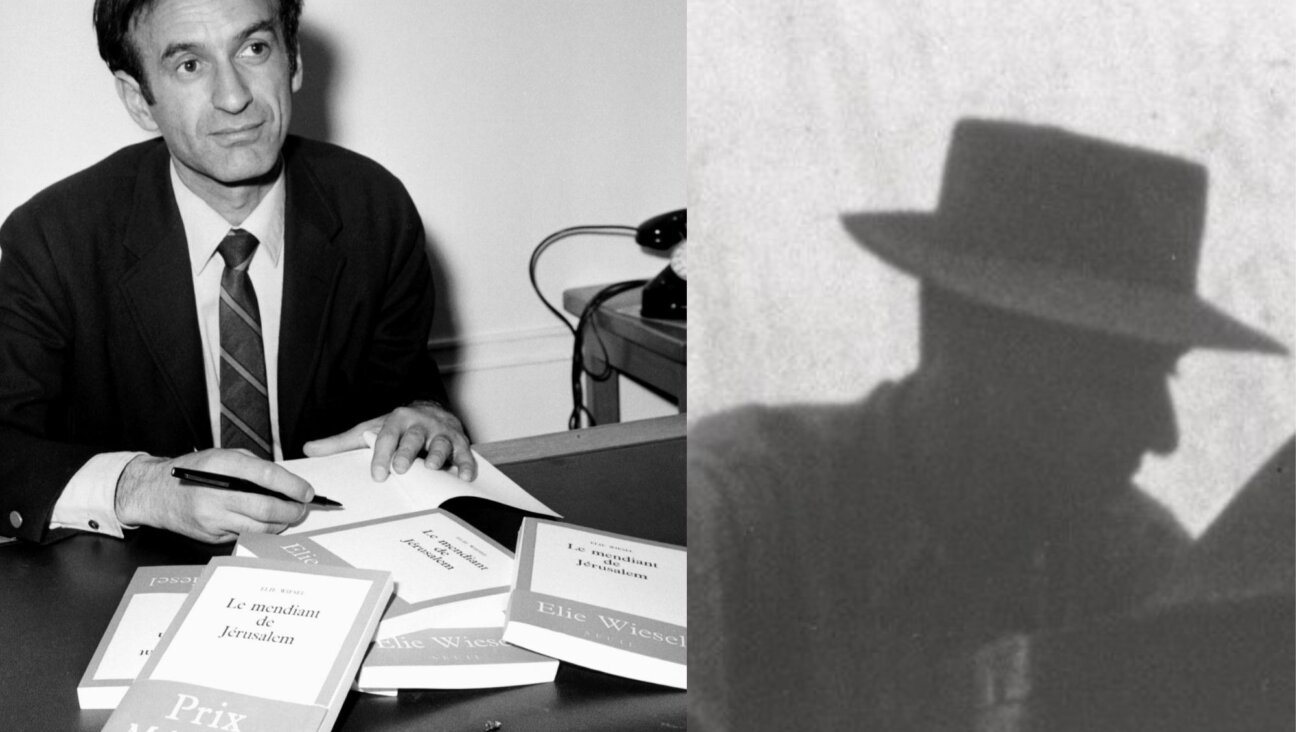The Forward’s news (and Jews) on the Bowery

Woman selling apples and man bending over apples as if selecting one to purchase. (New York, N.Y., 1930) Image by The Forward
The Forward is one of 57 libraries, museums and city agencies, contributing to a new app called Urban Archive, helping make historical materials engaging and accessible. This week, we look at The Forward’s coverage of the Great Depression and New York’s Bowery district. As a socialist paper, The Forward covered the plight of the poor and unemployed with special attention and energy. For more, check out our Urban Archive collection.
After the 1929 stock market crash and ensuing Great Depression, selling apples became a popular way to help now-unemployed New Yorkers eke out a living.
This 1930 photo from the Forward shows a somewhat unusual sight: a female vendor selling apples to a male customer. Historical sources indicate that the apple-selling scheme was directed at men who had lost their jobs and weren’t willing to perform traditionally feminine jobs.

A SCENE AT THE UNEMPLOYMENT CONFERENCE held at Beethoven Hall on the Lower East Side, where representatives of 250,000 organized workers passed resolutions to demand city government take immediate steps to mitigate plight of jobless. (Forward Photo, 3/20/30) Image by The Forward
The apple-selling era began in 1929 when the industry had a particularly large crop. The chairman of the International Apple Shippers’ Association, Joseph Sicker, decided to deal with the excess by funding the purchase of $10,000 worth of apples to sell to unemployed men at a reduced price so they could re-sell them at a profit. This scheme helped the apple distributors get rid of surplus crop and helped men earn some money, giving them a small sense of pride.
The program was very popular and the apple vendors became New York icons. The sight of the vendors tugged at the heartstrings of bystanders, who made a strong effort to buy their apples whenever they could. Customers and passersby were even known to donate clothes and meals to the sellers, moved by their bravery in standing on the cold streets and admitting their unemployed, struggling status to the world.
But by late 1930, the program became a victim of its own success. For one thing, the original surplus dried up but also, the apples became so popular that their price began to rise, so much so that the apple association couldn’t keep their prices low enough for the vendors to buy them; the scheme collapsed.
But women apple sellers eventually had their moment when Bette Davis portrayed one named ‘Apple Annie’ on the screen in the 1961 film, Pocketful of Miracles.
While most of the Depression-era apple vendors were men, the economic strain of the era pushed women into the workforce in historic numbers in other jobs. Employment for women rose from 1930-1940 by 24% — from 10.5 million to 13 million.

THE FIRST CHECKS OF THE UNEMPLOYMENT INSURANCE FUND won by the International Ladies Garment Workers Union were issued yesterday to unemployed clockmakers. Photo shows (left to right) Arthur D. Wolf, Chairman of the Board of Trustees of the fund; George Gordon Battle, issuing the checks and E.W. Katz and Mrs. Jennie Knissbaum, members of the Union. (6/9/25) Image by The Forward
A number of factors drove this change. First, most of the jobs available to women were in industries less impacted by the stock market. Second, many wives and mothers who had previously worked only in the home were forced to seek outside work when their husbands became unemployed. In addition, marriage rates fell significantly during the Great Depression leading to a sharp increase in single women seeking jobs to support themselves.
But despite the surge of women in the workforce, wages remained woefully unequal, and many working women suffered when the Depression hit.
Black women as a whole were hurt when white women poured into the workforce during the Depression. Black women had been in the workforce since 1865 because most Black families were unable to survive on wages from a single job as employers tended to pay Black workers less. Many Black women were displaced by white women in the so-called “women’s work” jobs.
As a result of this and other factors, many Black families disparately suffered throughout the Great Depression. For example, 20% of Americans receiving federal relief during the Depression were Black. Many of them were farm and domestic workers in the rural South, where they had no pensions or safety net because these two groups were excluded from the 1935 Social Security Act.
Mexican American women were hit particularly hard by discrimination and scapegoating. This group was regularly blamed for taking jobs away from white Americans and accused of only having families in the U.S. so they could stay in the country.
Street vending, popularized on the Lower East Side with the puchcart businesses operated by so many immigrant Jews in the city, would not remain as successful or popular as it was in the early days of the Great Depression, especially among New York City’s mayors.
Years later, under pressure from store vendors, Mayor Fiorello La Guardia took up the cause of outlawing street vendors in 1934, according to The New York Times.
The Bowery has long been part of the mapping of the city’s character and imagination. Studded with hoboes, the local down and out and flophouses, it was also a corridor between the downtown of Wall Street and the beginnings of the city’s more lively neighborhoods of Chinatown, Little Italy, the East Village and Loisaida and Soho, invented by immigrants and artists.
In the 1920s, it wasn’t uncommon to set out to buy your newspaper in the Bowery. In 1924, the Forward featured a photograph of the “Newslady of the East Side,” who was stationed at Grand & Bowery. Grand & Bowery was also, the Forward told readers, once home to some of the city’s large mercantile and department stores such as Lord & Taylor.
The Forward covered the Bowery regularly. In 1927, the paper ran a series called “All About Jewish Hoboes.” In attempting to create data about the percentage of Jewish American hoboes, this was said: “In one of the transient lodging houses on the Bowery, near the Newport Hotel, shown above, commonly known as a flophouse or scratch houses, as the Plaza, the Belmont or the popular Uncle Sam’s House you might find from five to ten Jews out of a hundred lodgers. For all that, a steady stream of Jewish hoboes, day in and day out knock on the doors of charity, begging for food, clothing and shelter.”

A GRAPHIC PICTURE OF THE UNEMPLOYMENT SITUATION IN NEW YORK — Thousands of men out of work lined up around two square blocks, waiting for meal tickets distributed by “Lady Bountiful” (Mrs. Irving T. Bush, wife of the wealthy industrialist) at the Bowery and Second Street. The tickets are redeemed for food at the Bowery branch of the Y.M.C.A. 8 East 3rd Street. (Forward Photo, 3/16/30) Image by The Forward
During the Depression, the Forward featured more photos like the one of the unemployed apple seller. One of them depicted the “meal ticket” line extending two square blocks at Bowery and 2nd Street. The multitalented Marian Spore Bush, a dentist, painter, philanthropist and wife of a wealthy industrialist — nicknamed “Lady Bountiful” — gave the tickets out. The tickets could be redeemed for food at the Bowery YMCA at Bowery and 3rd St.
It was critical to the paper to keep reporting the difficult economic conditions of the country. In 1930, the Forward featured an image of a long line of men gathered outside Kane’s Employment Agency located at 2nd Street and Bowery, near the Bond Street Savings Bank building. There, despite Hoover’s most recent address stating that the economy was sound, these men were offered meals rather than jobs. The Forward also published images of the poverty in the Bowery and Cooper Square. In one of those images, another long line of men waited in what was termed a “bread line.”
And many Forward classifieds featured Bowery businesses like that of one A. Hillman who was listed among the Forward’s classifieds for “Old Gold Bought.” His address was 240 Bowery.
The Forward kept up its reporting on the difficult economic conditions of the country. From its 1930 images of unemployed women apple sellers, to its classified ads for merchants who would buy back your gold on the Bowery in 1934, to its coverage of the current unemployment crisis, the Forward’s stories about the impact of economic struggles on the community remain of vital importance to its readers.

















